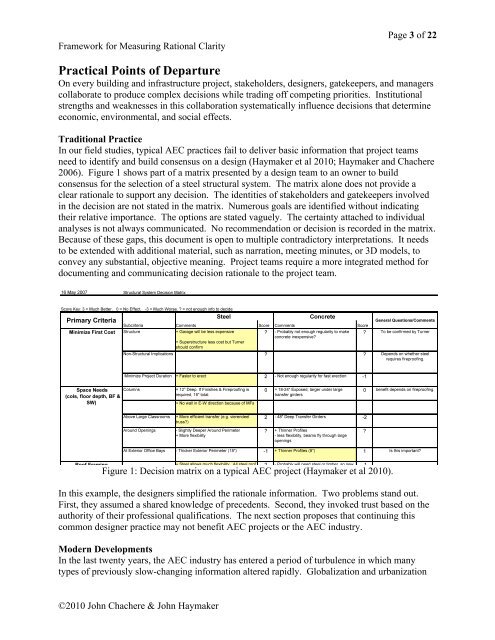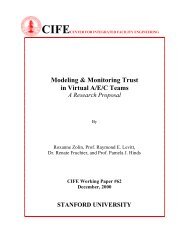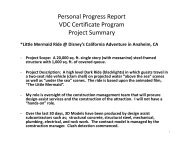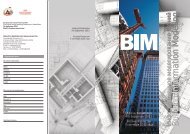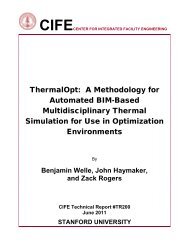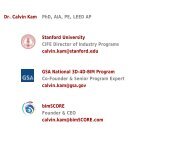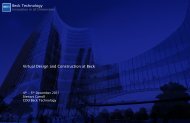Framework for Measuring Rationale Clarity of AEC Design Decisions
Framework for Measuring Rationale Clarity of AEC Design Decisions
Framework for Measuring Rationale Clarity of AEC Design Decisions
You also want an ePaper? Increase the reach of your titles
YUMPU automatically turns print PDFs into web optimized ePapers that Google loves.
<strong>Framework</strong> <strong>for</strong> <strong>Measuring</strong> Rational <strong>Clarity</strong><br />
Page 3 <strong>of</strong> 22<br />
Practical Points <strong>of</strong> Departure<br />
On every building and infrastructure project, stakeholders, designers, gatekeepers, and managers<br />
collaborate to produce complex decisions while trading <strong>of</strong>f competing priorities. Institutional<br />
strengths and weaknesses in this collaboration systematically influence decisions that determine<br />
economic, environmental, and social effects.<br />
Traditional Practice<br />
In our field studies, typical <strong>AEC</strong> practices fail to deliver basic in<strong>for</strong>mation that project teams<br />
need to identify and build consensus on a design (Haymaker et al 2010; Haymaker and Chachere<br />
2006). Figure 1 shows part <strong>of</strong> a matrix presented by a design team to an owner to build<br />
consensus <strong>for</strong> the selection <strong>of</strong> a steel structural system. The matrix alone does not provide a<br />
clear rationale to support any decision. The identities <strong>of</strong> stakeholders and gatekeepers involved<br />
in the decision are not stated in the matrix. Numerous goals are identified without indicating<br />
their relative importance. The options are stated vaguely. The certainty attached to individual<br />
analyses is not always communicated. No recommendation or decision is recorded in the matrix.<br />
Because <strong>of</strong> these gaps, this document is open to multiple contradictory interpretations. It needs<br />
to be extended with additional material, such as narration, meeting minutes, or 3D models, to<br />
convey any substantial, objective meaning. Project teams require a more integrated method <strong>for</strong><br />
documenting and communicating decision rationale to the project team.<br />
Figure 1: Decision matrix on a typical <strong>AEC</strong> project (Haymaker et al 2010).<br />
In this example, the designers simplified the rationale in<strong>for</strong>mation. Two problems stand out.<br />
First, they assumed a shared knowledge <strong>of</strong> precedents. Second, they invoked trust based on the<br />
authority <strong>of</strong> their pr<strong>of</strong>essional qualifications. The next section proposes that continuing this<br />
common designer practice may not benefit <strong>AEC</strong> projects or the <strong>AEC</strong> industry.<br />
Modern Developments<br />
In the last twenty years, the <strong>AEC</strong> industry has entered a period <strong>of</strong> turbulence in which many<br />
types <strong>of</strong> previously slow-changing in<strong>for</strong>mation altered rapidly. Globalization and urbanization<br />
©2010 John Chachere & John Haymaker


